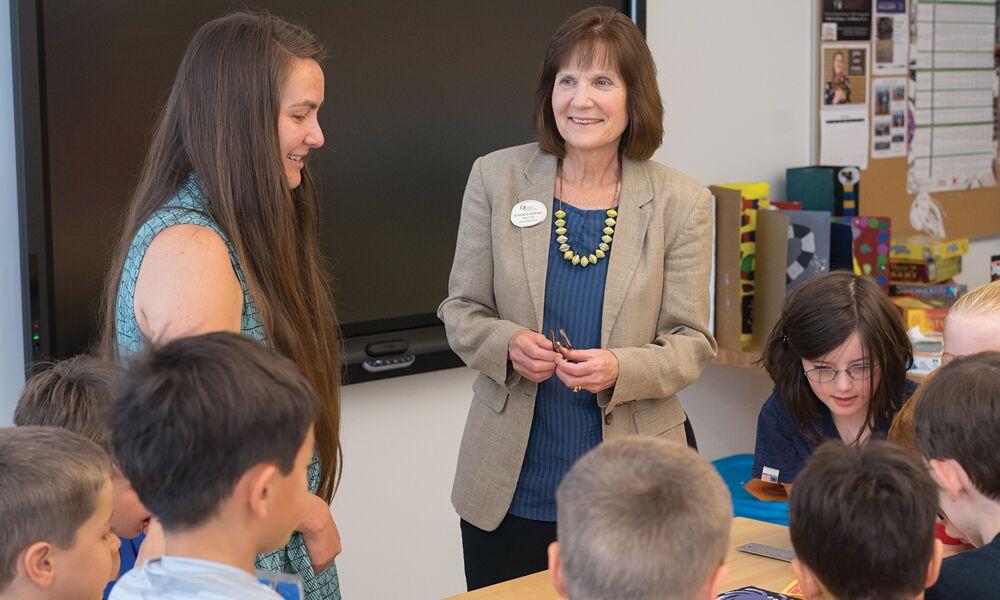Art and everything else
Education
SUMMARY: Professor Kathy Schwartz champions the role of art education in a visual world.
from the Winter 2018 issue of Madison
By Sam Roth ('17)
From convincing 56 school principals in Alaska to include art in the curriculum, to teaching art for 25 years in K-12 schools, to studying with Getty Center colleagues devoted to understanding the role of art in learning, Kathy Schwartz has become a pioneer in advocating for the inclusion of art education in public-school systems.
Schwartz, the director of JMU’s School of Art, Design and Art History, has seen firsthand how the art education field has grown—and battled its way—into a more permanent inclusion in public schools. “The arts are such an important part of how we tell our stories of what it means to be human,” says Schwartz. “I’ve devoted my career to art education because visual literacy is critical for innovation in any field, and for understanding world cultures, ideas and symbol systems.”

|
In Anchorage, Alaska, art classes were on the school board budget chopping block year after year, and Schwartz was asked to speak to why art was so important in learning. “I had to keep coming back, every year. The math teachers didn’t need to do that, or the science teachers,” says Schwartz. “So I thought to myself, ‘OK, what am I missing here?’” What Schwartz discovered was that rather than explaining the benefits of art education to school board members, she needed to show them what students were missing when art is not included in the school curriculum.
On a summer road trip after completing her undergraduate degree in art education, Schwartz traveled to Alaska by driving up the Alcan Highway through Canada with a few friends. Schwartz spent the summer working on a king-crab fishing boat before meeting a director of one of the northwest Arctic schools who asked her to stay and teach art, ultimately launching Schwartz’s career in the Alaska school system.

|
Children who are denied access to an art education are “deprived of an enormous amount of resources for discovering meaning in their lives,” says Schwartz. “If they don’t have access to the exemplars in the visual arts, poetry, literature, dance and music, how are they to know the difference between what is mediocre and what is sublime? How are they to be inspired to work toward excellence in their own lives?”
While most public schools today have progressed to including art classrooms in the buildings, many schools originally operated on the basis of “Art on the Cart,” in which an art teacher would travel to different schools and only get to see students every few weeks. Past models of art education have included programs in which the art teacher served as a break for general-classroom teachers, or programs where art teachers were asked to teach multiple different small art lessons a day.
“When I started teaching art in the ’70s, the primary focus was on teaching the elements and principles of design,” says Schwartz. “The rationale was that we would teach the children a visual vocabulary from which to work with.” Art teachers faced the challenge of convincing K-12 teachers to carry over and connect the art lessons into the students’ other work.
Art education has now evolved to include contemporary themes and concepts where art lessons connect to everything else in the curriculum. “We live in this visual world,” Schwartz says. “Art is the only subject in the school curriculum that’s entirely devoted to the study of images, understanding what their surface quality means and the deeper connotations that layer in the work.”

|
Administrators in Harrisonburg public schools understand the importance of art education, with every school having an art teacher. The SADAH’s Art Education Center partners with the Harrisonburg community to offer a summer art program for children to supplement the art education they are receiving in school, as well as outreach to retirement centers and art activities for both the Harrisonburg International Festival and the Very Special Arts Festival. The JMU students in SADAH assist in the Art Education Center while completing their Virginia K-12 education licensure requirements.
Since Schwartz became director of SADAH, she has expanded her support of the arts beyond art education. “In this particular role, I advocate for the faculty, students and staff and the programs we offer in Art History, Architectural Design, Industrial Design, Graphic Design, Studio Art, the galleries and the Art Education Center,” she says. “We are extremely fortunate to have a dean and associate dean who fully support the arts; a president and a provost who fully support the arts,” says Schwartz. “Our faculty, staff, students and administration see a connection between art and design and everything else. JMU is a wonderful place to work in the arts.”

|

